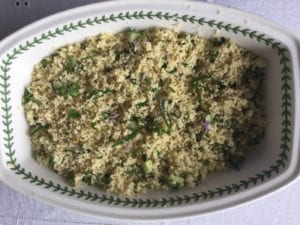Glasswort or marsh samphire Salicornia europaea grows on salt marshes, often around estuaries. It resembles a plant from Jurassic Park; a mini cactus but without the prickly spikes.
It is packed with alkali, which is why it was used in the manufacture of old English glassware - this is where the name glasswort originated.
When allowed, marsh samphire can form green carpets and glassmakers built their huts in amongst it for convenient harvesting. The herbalist Nicholas Culpeper praised the cleansing qualities of its juice.
Today, in Saudi Arabia, Eritrea and Mexico some species (there are lots and they are difficult to identify) of marsh samphire are cultivated off shore for the production of oil. In the winter months these cultivated plants make their way into British shops, as does glasswort from Israel.
In Scotland between late June and August you’ll find marsh samphire growing on mud flats and may find sea aster growing nearby. Some say that the best marsh samphire is washed daily, by the tides but I’m not sure that I could taste the difference. Pick high up the stem because the base becomes woody with age. The roots belong to the landowner and must remain.
When picking glasswort decent footwear is essential (I lost a shoe last week) and you’ll need a pair of scissors and a basket or bag.
Kneeling is my preferred option but test the sand/mud for terra firma; otherwise, it’s a backbreaking business.
This is the most delicious wild plant and when young, there is nothing nicer than carefully picking the tips from the muddy sand, washing it in clean seawater and popping it into an egg or salmon sandwich.
It is crunchy and bursts with seaside juices. Marsh samphire marries well with poached eggs, fish (with a hollandaise, if you aren’t on a diet) and lamb. If you find the honey scented sea aster, gather the thick leaves which taste mildly of the seaside, and pick a flower or two as well.
Refrigerate pickings in an unwashed state and wash as required.
Remove any woody stalks and rinse several times under running water before use.
Traditionally both marsh and rock samphire were pickled for preservation.
A clue to its habitat is in the name. Marsh samphire is found on marshy mud flats and rock samphire on cliffs. The author Patience Gray suggests that they are interchangeable in recipes. The author Jason Hill however, concurs with Dorothy Hartley et al. and writes of marsh samphire: "it makes a wholesome, though rather insipid vegetable dish, but it lacks the characteristic flavour of the true samphire"
He adds: "It cannot be used as a pickle."
I do pickle marsh samphire but my preference for both rock or marsh samphire is fresh.
Identification of marsh samphire is relatively easy but if you are anxious, check out a decent fishmonger’s counter before you head off to the beach.
Feeds 4

Ingredients:
• 200g easy cook couscous
• Approx 400ml seaweed or vegetable stock
• ½ washed cucumber, diced
• 200g marsh samphire, washed and chopped
• Handful chopped sea aster leaves and segmented flowers (optional)
• 75g chopped parsley
• zest and juice of a small lime
• Freshly ground black pepper
Method:
In a bowl rehydrate the couscous with boiling stock according to manufacturer’s direction. Leave to cool.
Fluff up the couscous with a fork and add the prepared ingredients.
Mix well, season and serve.
• Fiona Bird is the author of Kids’ Kitchen (Barefoot Books 2009), The Forager’s Kitchen (Cico Books 2013) and Seaweed in the Kitchen (Prospect Books 2015). Her latest book is Let Your Kids Go Wild Outside: Creative Ways to Help Children Discover Nature and Enjoy the Great Outdoors.